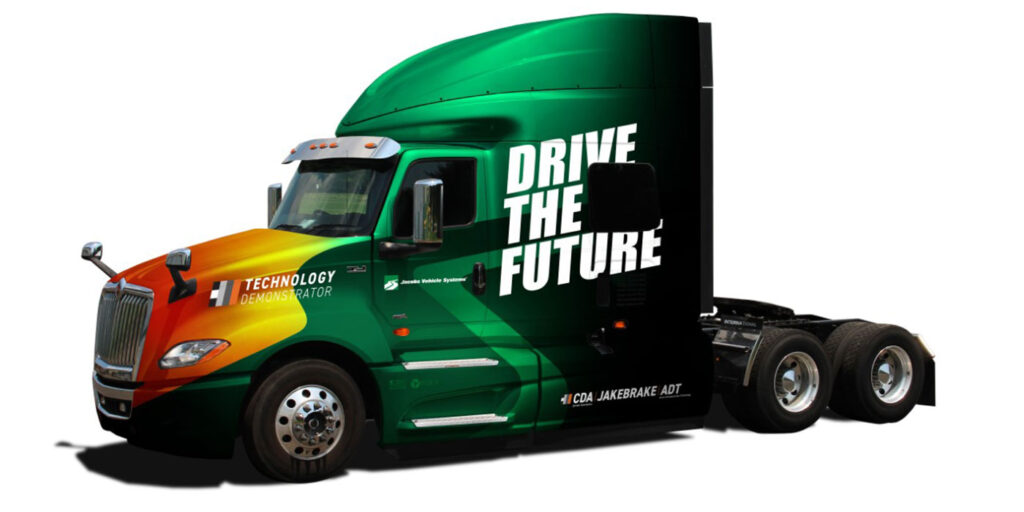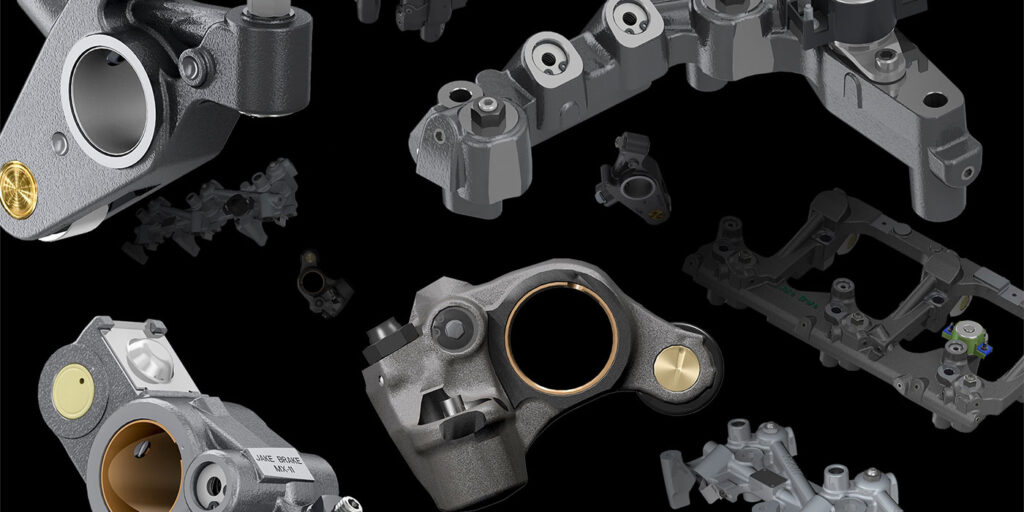The Jacobs Vehicle Systems demonstration vehicle will present fleets, drivers, industry associations, and original equipment manufacturers an opportunity to experience firsthand the value and performance features of two of Jacobs’ latest valvetrain technologies–Cylinder Deactivation (CDA) and Active Decompression Technology (ADT).
The custom-built International LT625 tractor with an A26 diesel engine will be subjected to a multitude of real-world driving situations in the coming months, according to Jacobs, to fully verify the fuel-saving, emission reducing, increased braking performance and enhanced driveability benefits of CDA and ADT.
Active Decompression Technology, explained
Jacobs’ Active Decompression Technology enables heavy-duty commercial vehicles to benefit from an engine stop-start system to eliminate engine-shake at both start-up and shutdown, the company explained. ADT also improves cold engine starts, reduces loading and wear on engine components during start-up, and makes start-up faster. In hybrid vehicles, ADT enables a faster transition from an electric motor to an internal combustion engine.
Though stop-start engine technology is widely adopted by automotive manufacturers, it is less common in heavy-duty commercial vehicles. This is largely due to the cost of additional technologies needed to mitigate increased wear-and-tear on the starter motor, ring gear, and battery. Jacobs’ Active Decompression Technology significantly reduces these issues.
ADT decreases the magnitude of engine-shake during shut-down by 90 percent, the company stated. This has the additional benefit of preventing disturbance to drivers sleeping in cabs overnight when there are automated engine starts and stops to maintain battery charge.
When starting up, the engine is kept in a decompressed state that decreases cranking torque by 40 percent and allows the engine to spin up to twice its normal speed for smoother starting, faster priming of the fuel system, and decreased wear on the starter gear, flywheel and other components. This can also allow the use of smaller and lighter batteries, cables, and starter.
By enabling the engine to be turned over while decompressed, ADT further improves start-ups in cold temperatures by enabling the engine to reach its critical compression ignition speeds, according to Jacobs. When combined with supplemental air inlet heaters, ADT enables the engine cylinders to be pre-warmed without the engine load from compression, which is especially useful when freezing temperatures reduce battery charge levels. When high cranking speed is reached, the engine compression is reactivated and fueling begins.
ADT can integrate onto multiple engine platforms.
Cylinder Deactivation, explained
Jacobs’ Cylinder Deactivation is a modular valve actuation technology that improves fuel efficiency by turning a six-cylinder engine into four-cylinders or less, potentially improving the overall fuel economy by as much as 25 percent, according to the company. Jacobs’ CDA reduces emissions by achieving higher exhaust and aftertreatment temperatures at low-load and start-up.
With Jacobs’ CDA, the cylinder deactivation mechanisms originally designed for the company’s High Power Density (HPD) engine brake are used in the valvetrain to disable the opening of the intake and exhaust valves.
The hydraulically-activated mechanism is integrated in a collapsing valve bridge system for overhead camshaft engines or with a collapsing pushrod system for cam-in-block engines. When this is combined with disabled injection in selected cylinders, multiple cylinders can be deactivated as needed. The deactivated cylinders act as a gas spring and return the compressed energy of the air back to the crank. As a result, at low engine loads with three of six cylinders deactivated, fuel consumption can be improved by up to 20 percent, Jacobs explained.
Jacobs’ CDA reduces emissions by achieving higher aftertreatment temperatures in the exhaust, which maintain optimal efficiency of the SCR system, even when the engine is in idle or low load operation. CDA also enables faster warm-up after engine start-up of the aftertreatment system and minimizes cooling of aftertreatment during coasting. Temperature increases of 100-200°C are achieved in low load conditions to maintain the SCR temperature of 250°C required for optimal NOx conversion.
In a low load cycle, a Class 8 truck equipped with Jacobs’ CDA and a Selective Catalytic Reduction (SCR) system experienced 77 percent reduced NOx emissions and 12 percent reduced CO2.
CDA additionally reduces camshaft friction, the company noted, reduces pumping losses in part-load conditions, and can reduce or eliminate use of the intake throttle, all of which yields overall improvements in fuel consumption while simultaneously increasing exhaust temperatures. CDA may also reduce the frequency and duration of active DPF regeneration events.
Jacobs’ CDA, its High Power Density engine brake, and other valve actuation technologies are modular and can be integrated into an engine individually or together. CDA helps meet both North American and European regulations with the same global engine platform.
CDA has been used for decades in passenger cars but is relatively new to trucking. Announced in 2018, Jacobs’ CDA hardware has so far been demonstrated on more than 20 different heavy-duty engine platforms, covering two to 15-liter engines, as well as 10 different heavy-duty truck road tests in North America, Europe, China, Japan, Korea and India. It has undergone more than 27,000 hours and more than 200,000 miles of durability testing. There have been more than 8 billion test cycles on CDA components and over 470 million cycles of fatigue and overload testing.
Jacobs’ CDA technology is also included in the US Department of Energy’s Super Truck II program, an initiative to develop and demonstrate cost-effective technologies that more than double the freight efficiency of Class 8 trucks.

CDA with Tula’s DSF controls technology
In 2019, Jacobs entered into a collaboration with internal combustion controls company Tula Technology Inc. The two businesses are working closely together to combine Tula’s Dynamic Skip Fire (DSF) controls technology with Jacobs’ CDA, where DSF optimizes Jacobs’ engine cylinder shutdown management in order to best meet torque demands and eliminate vibration.
Independent laboratory testing has demonstrated that, when combined, Jacobs CDA hardware and Tula’s DSF achieve greater emission reductions. In DSF, Tula has developed an infinitely variable cylinder deactivation control system, integrating advanced digital signal processing and software with sophisticated engine control algorithms that can allow CDA to be used in a larger operating range of RPM and torque than traditional CDA.
Tula DSF makes dynamic firing decisions based on how much torque is requested, then it selectively chooses which cylinders are active or deactivated to meet performance demand. When more torque is required, the firing density increases, and when there is less demand for torque, firing density decreases. The control algorithm effectively creates an engine with optimal displacement for the torque required.
Tula’s control system also ensures production level noise, vibration and harshness. By having the ability to select which cylinders are fired every engine cycle, and by taking into account the frequencies and amplitudes of vibration produced by cylinder combinations, the control algorithm determines the cylinder firing sequences that deliver smooth operation and reduced cost to the driver at the fuel pump.
Proven in independent testing
CDA is proven to increase fuel economy and reduce tailpipe emissions in heavy-duty diesel engines in the recognized Heavy Duty Federal Test Procedure (FTP) test cycles, including the Low Load Cycle (LLC). These benefits have been independently measured and quantified via an internationally known third-party laboratory and continue to be reaffirmed via Jacobs’ own in-vehicle testing currently being undertaken, Jacobs reported.
Dyno testing in Hot FTP and Low Load testing cycles
In February 2020, Jacobs published details of dyno testing with an internationally known third-party laboratory, funded by the U.S. Environmental Protection Agency (EPA), to quantify the fuel savings and emissions benefits of CDA. The tests, conducted on a 13-liter Navistar engine equipped with CDA, confirmed Jacobs’ own extensive test results. In a fixed three-cylinder deactivation configuration–meaning the engine was able to operate with six, three or zero cylinders–fuel consumption was improved by five percent over the baseline in the Hot (FTP) cycle, which covers engine warm-up, and the Low Load cycle, while increasing exhaust temperatures and limiting the cool-down of the SCR system.
To demonstrate the capability of the CDA system, the proposed CARB Low Load cycle was evaluated. CDA was found to raise the exhaust temperatures in order to improve SCR system efficiency so that tailpipe NOx emissions were reduced by 86 percent and CO2 and fuel consumption were reduced by 12 percent.
Dyno testing of Jacobs CDA with Tula DSF
In April 2020, a second technical paper, presented at the Vienna Symposium, revealed details of Jacobs’ CDA system working with Tula’s DSF technology on a Cummins X15 engine, which, under steady-state mapping conditions and employing zero to six-cylinder operation, demonstrated further improvements.
The paper stated: “At 1,000 RPM, diesel DSF shows an increase in exhaust temperature of nearly 100⁰ C while still improving fuel consumption by 25 percent.” NOx was found to be reduced by 45 percent and CO2 improved 1.5 percent over the baseline in the Hot FTP cycle. During the LLC7 cycle, NOx was reduced 66 percent and CO2 saw a reduction of 3.7 percent using DSF over the baseline engine.
In progress: In-vehicle testing of Jacobs CDA with Tula DSF
Jacobs is currently undertaking extensive in-vehicle, real world testing of CDA working with Tula DSF in its Navistar LT625 demo truck, equipped with a Navistar 13-liter engine.
Test results are showing when and for how long CDA is active in fuel-saving deactivation mode and the extent to which temperatures are raised. DSF is proving to be very active in maximizing the operating range of CDA. In Jacobs’ unloaded local town drive cycle, CDA has been active 49 percent of the time. Engine warm-up has been taking half the time as a non CDA-equipped truck, and the average SCR outlet temperature increased by 21.5°C.
Even in Jacobs’ highway testing cycle with a trailer, CDA has been active 22 percent of the time. A 107°C increase in minimum highway temperature was achieved coasting with zero cylinders activated, while there was no drop to thermal management mode. Engineers have observed no large swings in aftertreatment temperatures when transitioning from full to low loads.
Jacobs and Tula are continuing dyno testing of their technologies in parallel to real world testing, for both fixed speed and load testing using a full emissions bench, on the Navistar 13-liter engine. While “Transient FTP” testing results are pending, “steady state” results show an improvement in fuel consumption for loads of 400 NM or less, with fuel savings up to 25 percent at the lowest loads.
In warmup combustion mode, CDA with DSF is providing fuel saving benefits of up to 20 percent fuel and up to 300-350 NM. The temperature rise from warm-up mode combustion and CDA can exceed 240°C.
CDA and alternative ICE fuels
ClearFlame Engine Technologies–a growing start-up focused on a new engine modification technology that enables low-carbon and carbon-negative fuels to be easily integrated into existing heavy-duty diesel engine platforms–has teamed up with Jacobs to incorporate CDA into its engine.
Using decarbonized liquid fuels, such as ethanol and e-methanol, the ClearFlame engine modification technology significantly reduces greenhouse gas emissions, particulate matter and smog, helping to meet stringent emissions regulations while reducing overall engine systems cost. It provides the same performance, efficiency, and rugged practicality associated with diesel engines, while eliminating the need for costly aftertreatment solutions.
The higher temperatures, he added, are necessary to limit harmful emissions that otherwise would be released into the environment by a combustion engine’s exhaust aftertreatment systems during cooler vehicle operation.














